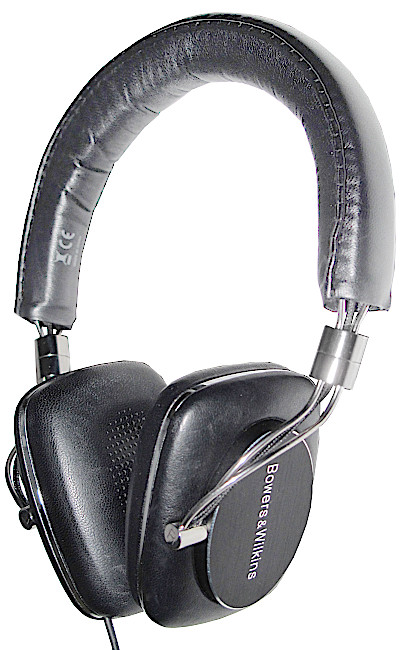P5 (Series 2)
back to Bowers & Wilkins
back to measurements
home
published: Dec-24-2023
NO SMOOTHING is applied to the shown plots. Most measurement sites have some smoothing applied which ‘irons flat’ sharp peaks and ‘wiggles’. I do not use smoothing because some info about sound quality is lost when plots are smoothed.
Aside from a small correction of the microphone itself also some correction in the lowest frequencies is applied to the plots to compensate for the perceived loss of bass when using headphones. This is described HERE in more detail.
A ‘horizontal‘ frequency response curve on the shown frequency response plots on this website thus indicates a perceived ‘flat’ tonal signature.
ALL measurements are made with a good SEAL on a flatbed measurement rig.
The shape of your head, bone structure, pad size, pad ‘softness, (compliance), hair or no hair and or wearing glasses may (drastically) change the frequency response of some headphones, so… your personal experience may differ substantially from these plots.
Frequency response (tonal balance) is the most sound-determining aspect of headphones. A horizontal line shows audible neutral response in the plots on this website. Deviations in different severity at different frequency bands have an effect on the sound character.
The bigger the deviation the stronger the effect.
Below an aid to help determining the sound character of headphones with relation to the frequency response.
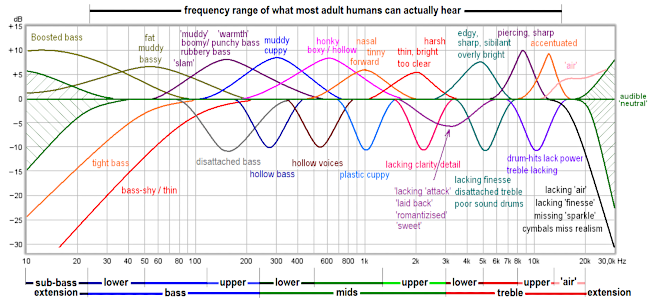
Bowers & Wilkins P5 (series 2)
The Bowers & Wilkins P5 series 2 is the successor of the original P5 (2010-2015).
Bowers and Wilkins is a luxury brand and primarily known for their loudspeakers.
The P5 (S2) was launched in 2014 and discontinued in 2020. At launch it was around € 290.- and dropped to around € 150.- within 2 years.
It has luxury feel and looks and the design matches that. Metal and leather materials are being used.
The headband is leather covered and is a bit narrow with thin padding so the part that is resting on the head is not very comfortable.
The headband can extend 30mm and stays put once adjusted to the desired position.
Clamping force is a bit high (2.5N) for an on-ear but because of this it can create a decent seal (which is really very important for this headphone) and stays on the head when moving around.
Its weight of 196 gram is rather low for a headphone that uses metal parts caused by the higher quality metal used.
The cups can swivel about 100°. The tilt is limited but big enough to get a good seal on most head sizes. In one direction the pads can lie flat on a table, in the other direction (speakers facing upwards) the angle is limited.
The real soft leather pads are exchangeable (held in place using magnets) feels quite soft to the touch and has memory foam inside. While the pads appear to be quite thick they can only be compressed a few mm. Inside the pads there is a plastic ‘wall’ preventing the pads to be compressed more than a few mm.
I have not found the original pads nor aftermarket pads for this headphone but it may be possible to order directly from B&W.
Height is 70mm, width is 55mm, thickness of the foam is 3mm.
It is a closed headphone and offers some isolation from outside noises.
The cable has a soft silicone feel and is 1.2m long and fortunately low in microphonics. There is a mic/remote in the cable. On the headphone side it has a gold-plate 2.5mm TRRS jack under the pads and on the source side a nickel-plated 3.5mm TRRS connector wired to comply with CTIA standard (Apple).
Also included a 1.2m universal cable that terminates in a gold-plated 3.5mm TRS jack.
The 2.5mm TRRS connector in the headphone allows the usage of balanced drive when an appropriate aftermarket cable is used. It has to be designed specifically for the P5 though.
NOTE: This means with some 6.3mm adapters and on some android (OMPT standard) devices the P5 S2 may not sound great, distort or not work properly because of the CTIA standard used.
One can buy an CTIA to OMTP converter or use the supplied 3.5mm TRS cable.
With a high sensitivity of 117dB/V and an impedance of 24Ω (measured) the P5 S2can be used wired directly from a phone and reach decently loud levels even from E.U. phones.
E.U. phones are often limited to 0.5V max. where other regions can be 1V.
This reviewed headphone is for sale
specifications:
Type: On ear (supra-aural), closed
Usage: Home, portable
Driver type: dynamic
Pads: replaceable, real leather
Collapsible: No, but can fold flat.
Headphone cup connector: 2.5mm TRRS non-locking (under the pad)
Cable entry: single sided (left side).
Cable: 1.2m in a straight gold-plated 3.5mm TRRS jack (Apple) or 3.5mm TRS
Pad dimensions: height = 70mm, width = 55mm, thickness = 3mm
Driver size: 40mm
Nom. power rating: 50mW (0.05W)
Max. voltage: 1.1Vrms (3.1Vpp)
Max. current: 45mA
Max. S.P.L.: 118 dB
Impedance: 24 Ω (measured)
Efficiency: 101dB @ 1mW
Sensitivity: 117dB @ 1V
Weight: 196 g. (without cable)
Clamping force: medium/high (2.5N)
Accessories: luxury carrying bag, 2 cables, one with Apple mic/remote.
Subjective sound description:
Bass is well extended and ‘punchy’ but also ‘woolly’. The mids lack ‘body’ and ‘clarity’. The treble is rolled off, lacks sparkle and is coarse.
Measurements:
Below the frequency response of the P5 S2 (Left, Right) 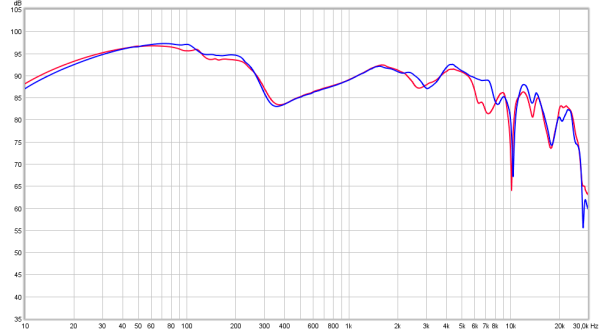 The channel matching is excellent. Bass is elevated and very well extended. The dropping response between 200Hz and 300Hz and rising again to 1.5kHz gives the headphone a bassy and ‘powerful’ sound but missing in fullness of the mids. The mids do sound ‘forward’ but are overpowered by the upper bass. The gradual drop in treble above 5kHz makes the treble subdued and give the overall tonality a darker character missing ‘sparkle’ and ‘finesse’.
The channel matching is excellent. Bass is elevated and very well extended. The dropping response between 200Hz and 300Hz and rising again to 1.5kHz gives the headphone a bassy and ‘powerful’ sound but missing in fullness of the mids. The mids do sound ‘forward’ but are overpowered by the upper bass. The gradual drop in treble above 5kHz makes the treble subdued and give the overall tonality a darker character missing ‘sparkle’ and ‘finesse’.
Phase response
Below the phase response of the P5 S2 (Left, Right) 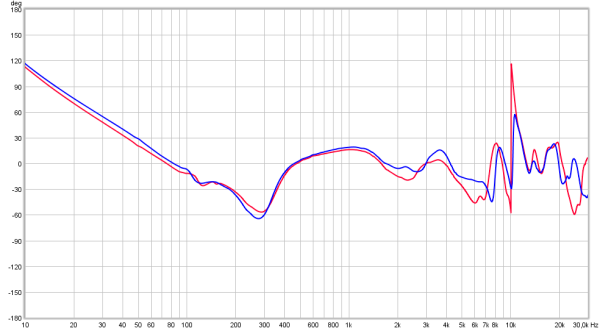 Slow phase shifts are not very audible. Sharp changes in a narrow frequency bands may well be audible. Above 7kHz there are steep phase shifts. This usually is an indicator for poor treble quality.
Slow phase shifts are not very audible. Sharp changes in a narrow frequency bands may well be audible. Above 7kHz there are steep phase shifts. This usually is an indicator for poor treble quality.
comparisons to other on-ear headphones
Below the B&W P5 S2 versus some other on-ear headphones. The response is smoothed to get a better sense of audible differences between the headphones.
Note: The AKG N60 is the only one that has Noise Cancelling.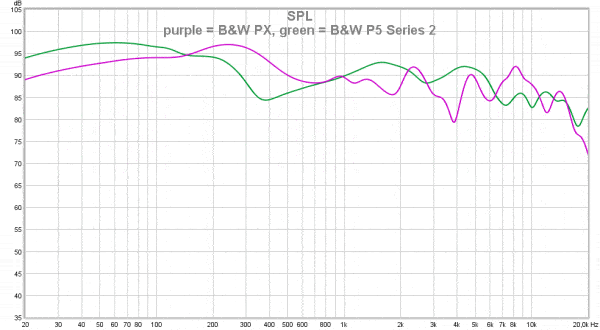
output resistance / damping-factor
As this is a dynamic headphone the frequency response can be amplifier output resistance dependent when certain higher output resistance amplifiers are used.
Instead of showing impedance plots, which are hard to ‘read’ when it comes to assessing the tonal balance change in the real world, the P5 S2 is measured via 4 different resistance output amplifiers (0.2Ω, 10Ω, 33Ω and 120Ω). On a higher output resistance amplifier the output level will be lower of course due to voltage division. To compensate for this the amplifier is cranked up to the same level (14.8dB for 120Ω at 1kHz in this case). This way the plots are overlaid and it is easier to see how the tonal balance changes. 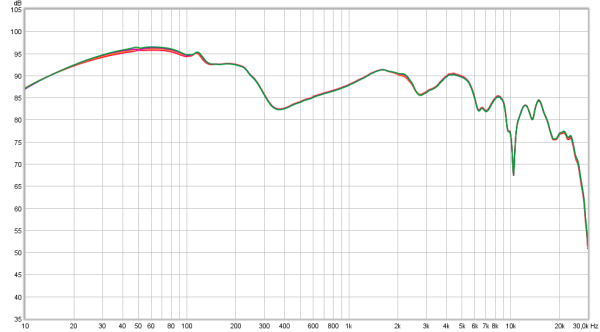 The impedance of this headphone is quite ‘flat’ so the tonality of the music is not any different when using this headphone with low or higher output resistance amplifiers.
The impedance of this headphone is quite ‘flat’ so the tonality of the music is not any different when using this headphone with low or higher output resistance amplifiers.
seal
Seal is an issue with closed-back headphones. This headphone is no exception and is even highly dependent on a good seal. Slightly lifting the pads or hair between the headphone and the ear directly affects bass extension.
Perfect seal, by a very slight lift of the pad, Seal broken a tiny bit more.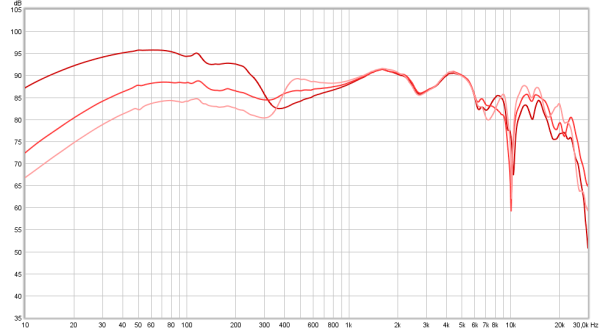
Only with a perfect seal there is elevated and extended bass. Just a very slight seal breakage will result in loss of bass.
Below the distortion measurements of the P5 S2 (left channel)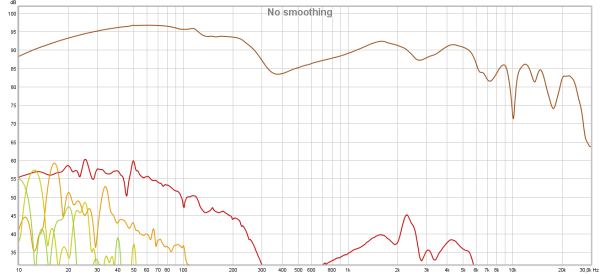 The plot above shows the level differences between the signal (upper trace) and the harmonics.
The plot above shows the level differences between the signal (upper trace) and the harmonics.
Most people prefer to see percentages instead of level differences so below the exact same plot except ‘normalized’ to the actual signal and level differences given in percentages.
Distortion is kind of high for a closed headphone in the lower frequencies.
The actual 2nd harmonic distortion above 400Hz may well be lower than 0.2% . A shortcoming of my measurement rig.
Below the CSD (waterfall) plot of the P5 S2 (Left and Right are overlaid) In the lower midrange there is some lingering going on. Above 2kHz the driver is well damped and does not show issues in the time domain.
In the lower midrange there is some lingering going on. Above 2kHz the driver is well damped and does not show issues in the time domain.
Below the Group Delay plot for the P5 S2 (Left, Right) There is some small pad bounce visible at around 110Hz and some resonances in the 150Hz-400Hz range.
There is some small pad bounce visible at around 110Hz and some resonances in the 150Hz-400Hz range.
Step response
Below the step response plot which, when the sound is balanced and well extended should show a fast rise to around 0dB, (indicating fast driver response) and then should be slightly sloping downwards indicating bass extension. (Left, Right)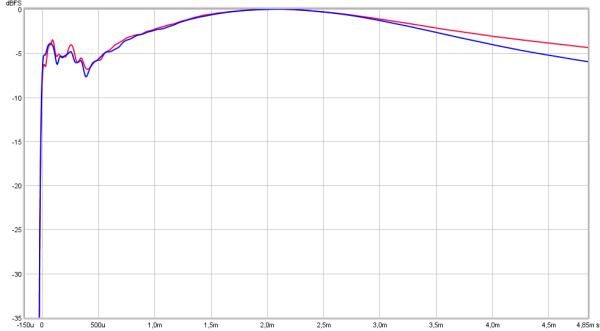
Bass extension is very good (with a good seal) as indicated by the horizontal part barely sloping.
The initial rise is reaching only -5dB and then only slowly rises after 500μs over the following millisecond.
This shows the ‘dark’ sound signature and lack of clarity/brilliance.
conclusion
The Bowers & Wilkins P5 Series 2 is a premium looking and feeling headphone.
It is no longer available and was fairly expensive when launched but has real leather and metal parts giving it a quality and luxury feel.
But then there is the comfort. When you (have to) wear glasses this headphone is not for you.
The rather high clamping force (for an on-ear) is getting uncomfortable quickly in this case.
Even without glasses a lot of people will find it a bit uncomfortable after a while.
Another even more important aspect is the sound. Having read multiple reviews about the pleasant sound it is supposed to have I was disappointed to find out it does not sound anything like what the press would want us to think. Even headphones 1/10th the price can sound better.
Yes, it does have punchy bass (with a good seal) but that’s where the positives stop.
The mids are inaccurate and muffled, lacks dynamics and clarity. The treble is way too low in level and lacks sparkle and finesse.
Fortunately… with some parametric EQ this headphone can be saved (up to a point) when it comes to sound.
The sound quality is completely insufficient for audiophiles. The bass is not tight, the sound too warm, it lacks clarity and presence and the treble is subdued and of poor quality.
It is obvious most of the price went into premium materials and looks, alas not in sound quality.
Is it completely worthless ? Fortunately not but it is not worth € 290 nor the € 150 what it sold for in the end. The value (sound quality wise) is somewhere between € 50.- and € 100.-
The reviewed headphone is for sale

